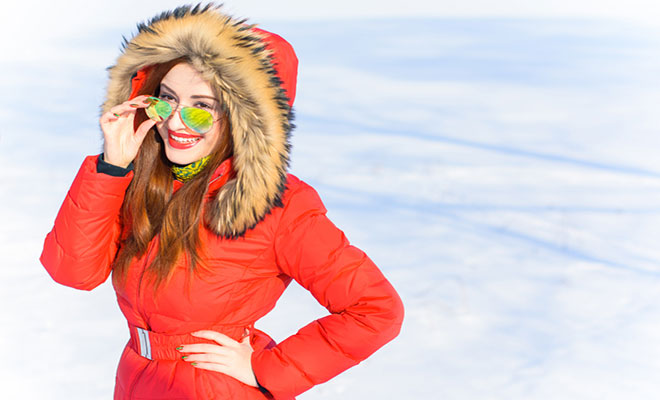Protecting your skin no matter what the weather condition is outside should always be a priority.
During the winter season, the harsh climate can do more than just make you feel cold.
Just because you cannot see the sun does not mean you will not experience its harmful rays.
Hate to break it to you, but cold clouds can never block the ultraviolet radiation emitted by the sun.
Sunburn and windburn can are the two most common skin issues you might experience if you do not apply precautionary measures.
All About Sunburn

Sunburn Skin – Image/Shutterstock
People naturally assume that you can only get a sunburn during summer or sunny days, but sorry to have to break it to you – about a whopping 50 to 80 percent of UV rays can go directly through the clouds.
No, they do not have any filtering power whatsoever, so just because it looks gloomy outside does not mean there is no need to grab a bottle of sunscreen.
In fact, according to experts, snow and ice can make things worse during the winter season.
People who head to the mountain tops or just about any elevated land, like snowboarders for example, actually have increased exposure of around 10 percent for every thousand feet of elevation.
About 80 percent of the rays that reach the ground can get deflected.
This means that there is a higher risk of getting hit by the harmful UV rays since you can get hit from two angles.
What causes sunburn on the face and other parts of the body?
Adults from 18 to 29 years old are the most reported age group to experience this.
It is never the heat that causes the damage or the burn. Sure, it can bring some discomfort and everything, but it is the excessive exposure to UV rays that actually creates the damage.
It increases the production of melanin and sends it into overdrive.
This will cause you to get a shade or two darker, and when this happens, it is your body’s way of telling you that it is defending itself from the sun.
However, melanin production can only do so much. If your body cannot produce enough melanin to protect your skin, outcomes the sunburn.
All About Windburn

Windburn Skin – Image/Courtesy WordPress
Most people consider windburn of being caused only by the drying effects of the wind (hence, the term windburn), but others consider it to be caused by UV rays as well.
People who are exposed to windy, dry, or cold have high chances of experiencing windburn.
Ice skaters, snowboarders, and skiers are always at high risk as they are often exposed to cold weather.
Exposure to brisk and dry air can create very unlikely results for the skin.
If you are wondering What Does Windburn Look Like, it is similar to sunburn, but can sometimes itch or swell due to the depletion of moisture.
What causes windburn on the face and other parts of the body?
Windburn is often caused by the skin’s exposure to cold and strong winds for a long period of time.
The skin gets irritated from the coldness of the wind, and the gushing of the low humidity wind can strip the skin of its natural oils.
This causes immediate damage to the skin, since the moisturizing factor and UV filter are both lessened, providing less protection for the skin.
How To Tell The Difference Between Sunburn And Windburn?
This may be a bit hard to identify because windburn can resemble a sunburn. Both can manifest as red, hot, dry, and painful. That being said.
However, it is very much possible to get windburn along with sunburn. The key difference between sunburn and windburn is that windburn occurs only when exposed to cold humidity.
While sunburn, on the other hand, can be experienced under warm and cold climates. Other differences worth noting are:
- Sunburn is brought about by direct exposure to harmful UV rays, while windburn is caused by chilly wind.
- Sunburn lasts longer than windburn.
- The damage is greater for people who are experiencing sunburn.
- Windburn most likely presents as rash and can get itchy.
- Sunscreen can protect you from sunburn, but it will not be enough for windburn.
- Windburn is what happens if you don’t moisturize well enough if you are going to cold and dry areas with low humidity.
Prevention is always better than cure, so it is really important that you protect your skin every day from harmful sun rays or cold winds.
However, if things have already gone downhill for you, here are some things you can do to help yourself.
How To Get Rid Of Sunburn Skin?
Get your body to cool down:
- This is one of the effective ways how to reduce sunburn redness fast. You can do this by wetting a washcloth and pressing it against burnt skin. Avoid using ice.
- It can cause more irritation. Running cool water for over 15 minutes is preferred by those who cannot tolerate cold compression.
If the soreness is too much to bear, maybe it is time to get some anti-inflammatory drugs at the pharmacy:
- Ibuprofen, mefenamic acid[1], or aspirin can do the trick.
- However, if the sunburn is really severe, go consult a dermatologist.
- You might get a prescription for a topical anti-inflammatory like Diclofenac. It can reduce swelling and inflammation in a jiff.
Apply aloe vera on skin:
- Not only will it soothe the inflammation, applying aloe vera is a small step on how to make sunburn skin lighter.
- Refrain from using products that contain alcohol ingredients. It can cause too much drying that can aggravate the condition.
No matter how tempting, avoid popping the blisters:
- Not all people who have sunburn can get blisters, but if you happen to be one of the unlucky ones, touching these will not help your cause.
- Instead, use gauze to cover them lightly. Once the blisters break, quickly apply a topical antibiotic to avoid infection. Cover it again with a new set of gauze.
Speed the healing up by avoiding interaction of the damaged skin to any surface:
- This means avoiding tight clothes.
- Not only is it more comfortable to wear loose clothing, doing so will allow your skin to breathe and recover more quickly.
- Wait for your skin to completely heal, before applying some of the best skin brightening products to regain previous complexion.
How To Treat Wind Burn On Face and Other Affected Areas?
- The best way to treat windburned skin is to boost its hydration. Products like coconut oil can lock in the much-needed moisture. Apply it to the affected part after every few hours.
- In addition to that, applying lip balm more often than usual is the perfect way on how to heal windburned lips.
- Get some eye drops if your eyes are also suffering some irritation.
- Skin irritation and itching is the worst part of having windburn skin.
- Get a moisturizer that contains hydrocortisone to ease yourself. This can help reduce skin inflammation.
- All of these can make your skin a lot drier as they tend to dehydrate the moisture left on the skin.
- Picking on your skin may lead to infection. It may also make the peeling a lot worse.
- Just avoid fussing with your skin too much and let it heal on its own.
- Take frequent cool baths or showers to help relieve the pain.
- Use a moisturizer that contains aloe vera or soy to help soothe sunburned skin.
- Consider taking aspirin or ibuprofen to help reduce any swelling, redness, and discomfort.
- Drink extra water.
Hydrate your skin:
Address itching and skin irritation using a medicated cream:
Avoid heaters, fires, or hot showers for the next few days:
Do not pick on the peeling skin:
Some of the most helpful tips to reduce sunburn and windburn is to moisturize the skin regularly and always apply sunscreen for further skin protection.
Take good care of yourself by taking care of your skin.
FAQ’s:
Que: Does windburn turn into a tan?
Ans: No, it does not activate our skin to produce a suntan.
Que: Is windburn the same as sunburn?
Ans: Yes, windburn symptoms are the same as sunburn symptoms and include red, burning, and sore skin that may peel off as it begins to heal.
Que: How do you get rid of windburn on your face?
Ans: Preventing windburn is the same as preventing sunburn, apply sunscreen to exposed skin and wear sunglasses as well as protective clothing.
Que: How do you heal sunburned skin?
Ans:
 By Wendy Gould
By Wendy Gould





